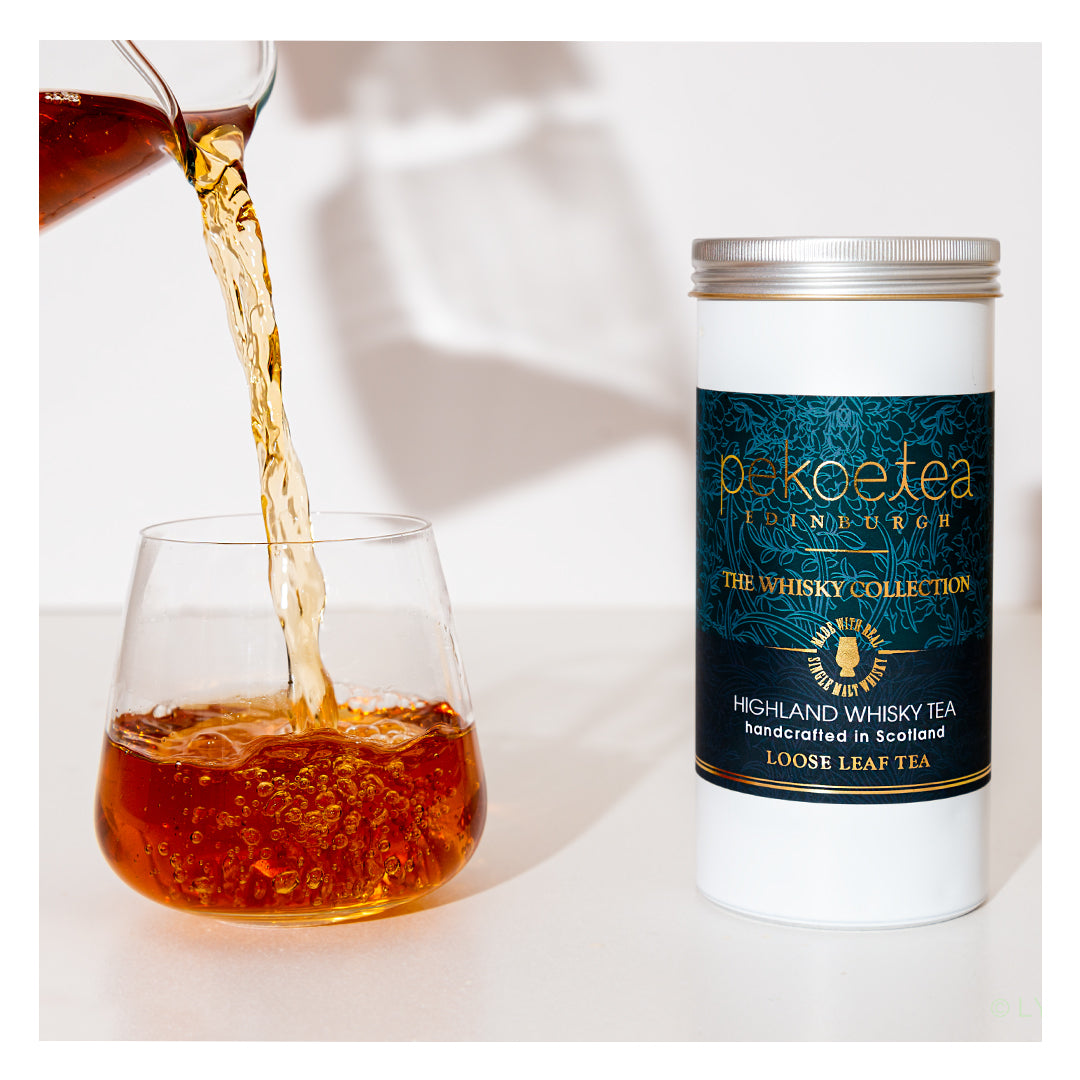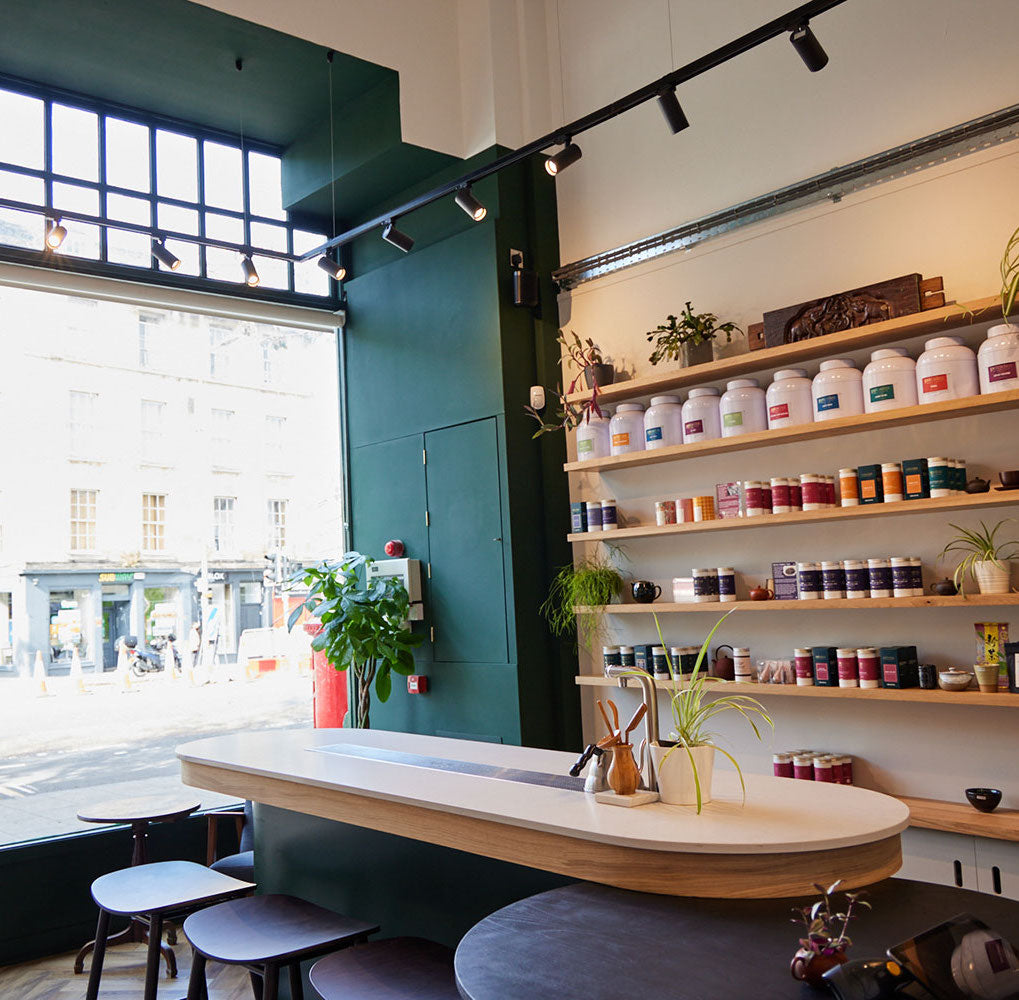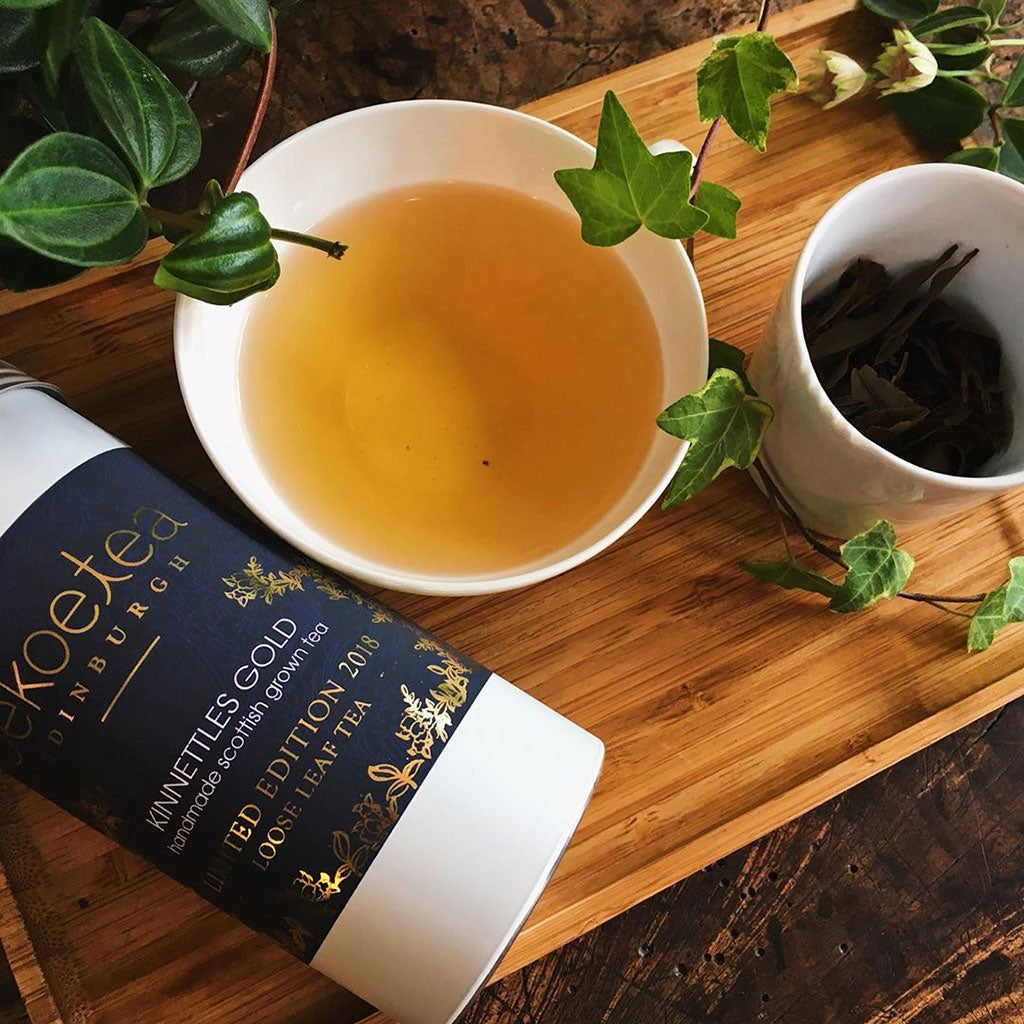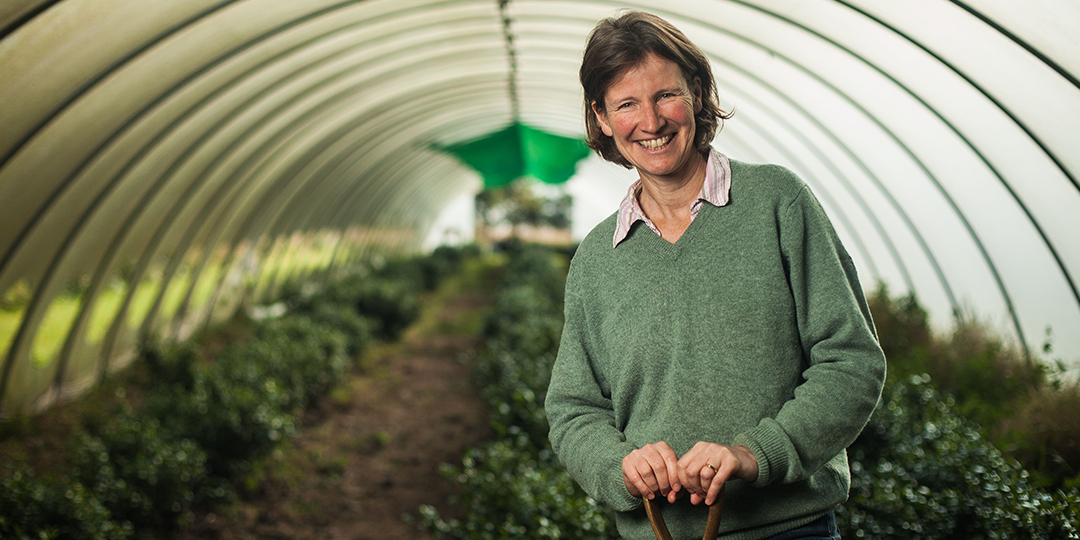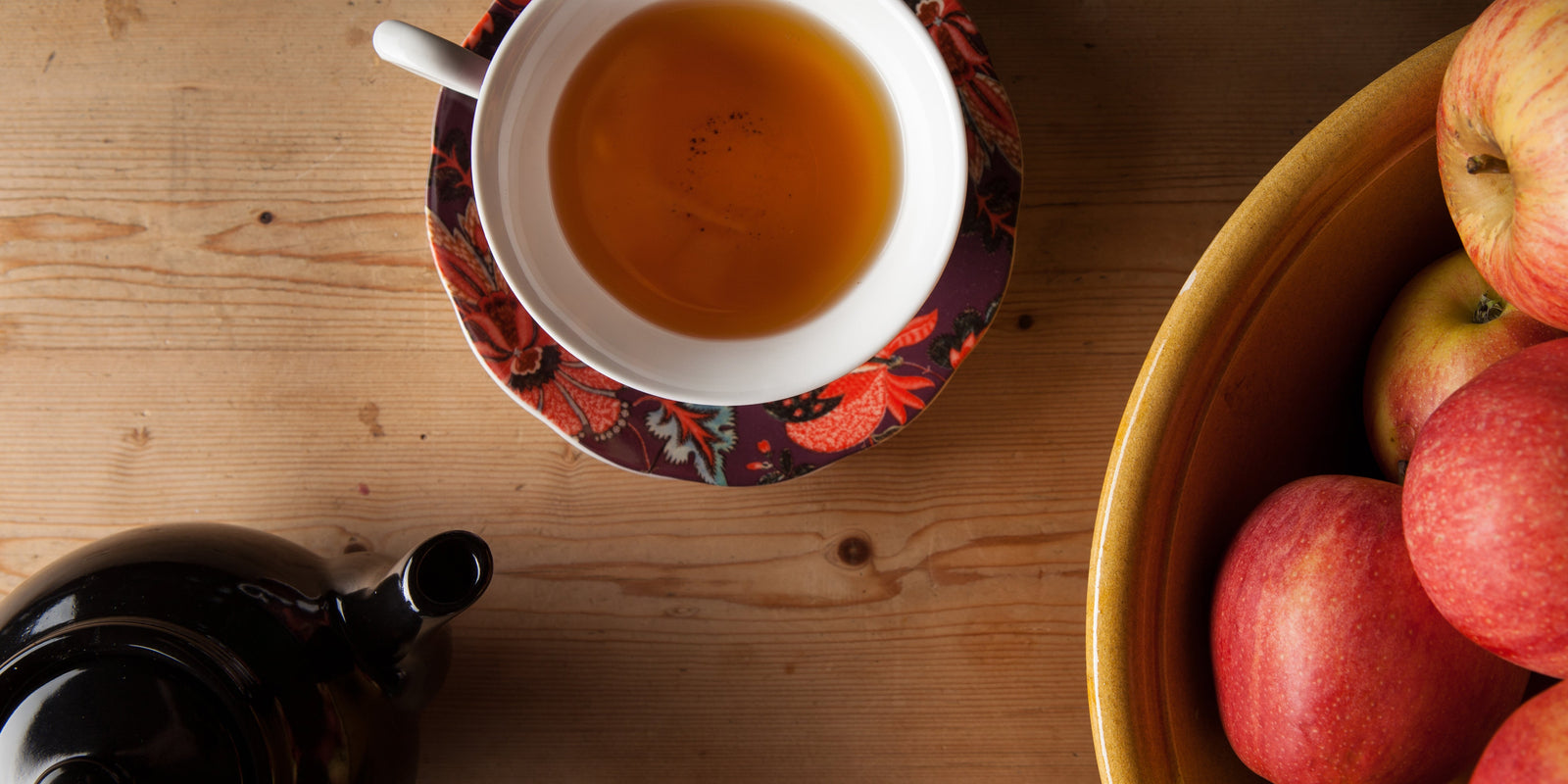In this interview, Pekoe Tea owner Jon talks to Susie Walker-Munro from Kinnettles Tea Estate, one of the founding members of Tea Gardens of Scotland and the first person to successfully grow 100% Pure Scottish Black Tea in Angus, called “Kinnettles Gold”which launched on the market in 2015.
Jon: What was your inspiration to start growing tea in Scotland in the first place?
Susie:It started a long time ago, back in 2007, we have a farm up here {in Angus, Scotland], it’s an arable farm and we were looking to diversify, find a slightly higher-end crop. Because we have a lot of areas around the farm that it is difficult to get large machinery into, it seemed worth looking into. Fortunately I read an article in a dentist’s waiting room about growing tea down in Cornwall and I thought, hmm, let’s try it! So that’s the background, that’s how I got into it.
Jon: When I talk to customers about Kinnettles Gold they always ask me, is it not too cold to grow tea in Scotland? What’s it actually like, trying to grow it. Is our climate suited to growing tea?
Susie:Well, the simple answer is they’re absolutely right! It is too cold! However, you have to bear in mind that tea doesn’t like high winds, it doesn’t like slushy wet snow either, so if you can mitigate that to as great an extent as you can then you have a project. Thankfully, tea is dormant in winter, so when the weather is at its absolute worst tea bushes have completely seized up so that first flush, when it happens, is absolutely delicious because the plants are basically stressed. So in answer to that question is: it’s very small yields, tiny yields, but a very lovely, high-end, beautiful tea. We have to look after them, to nurture them, basically.
Jon:You said you first planted your tea in 2007, so how long does it actually take from planting before you can actually pick and produce something from the plant?
Susie:Hmm, well it’s a bit like growing an orchard, you do have to wait some time, you’re looking at four to five years before you can actually start plucking. The thing is when we first started planting in 2007 we planted outside and the weather was just too rough and too tough and - these were cuttings - and it was a real struggle. So we then started again using polytunnels and that provided that protection. It allowed for season extension and it allowed us to look after our bushes more easily, to give them the good liquid manures from all the nettles, the comfreys and docks, dickens here we have in Scotland. So we were able to care for our Kinnettles Goldand really give it the best conditions possible. Our Kinnettles Golds are ten years old now and they are doing well.

[image by Tea Gardens of Scotland]
Jon: So we first bought Kinnettles Gold in 2015 so it really did take that long between planting and the tea being ready to make something as good as Kinnettles, then?
Susie:Yes, and also I made a lot of mistakes in 2014 and then I had a lot of ideas then that I wanted to try out which I had picked up when I was out in Darjeeling and I wasn’t hitting the mark. We lost a year really until I sought some consultancy help to really fine tune things and have a tea that I was happy that you would like.
Jon: When I first tasted Kinnettles Gold back in 2015, I was very impressed by the quality and its unique flavour. It was important to me when I was buying it that it wasn’t just a novelty product but that it could stand up to the quality of the handmade teas from the more traditional tea-growing countries which I really do think it does. So tell us a bit more about what goes into making Kinnettles Gold and how you get such fantastic tea.
Susie: Right, well it starts with the plucking. A bud and two leaves, we don’t do a coarse pluck. And we make sure that leaf isn’t hanging around before it gets onto the withering rack, so it doesn’t get knocked about. Sometimes overseas you see the leaves sitting in baskets for a little bit too long. Also, because we pluck well, there isn’t any stick or leaf vein or anything like that. So we don’t have wastage. Our ratio is about 4.3 kilograms of leaf would have to be plucked to get your 1 kilogram of tea.
Jon: So you really need to pick a lot to get enough for the finished product. So how long does it take then for a batch of tea from the picking to the finished leaf tea?
Susie:This is always a difficult question, because it depends, but if we say roughly 24 hours. But it depends, because if you pluck on a day when it’s really windy or really dry then the leaf isn’t going to need as much time withering and it’s all about how you get moisture out of the leaf, so it can be anywhere from 16 to 20 hours of withering. After that you have the rolling and that time depends on the condition of the leaf when it comes off the wither, then you have your oxidation stage which could be 2 ½ hours, maybe even three hours, it is all dependent on the climate and condition. Then finally you get the tea to the ovens. So I like to say 24 hours because it’s a simple answer but it can vary.
Jon: So we buy two kilos from you roughly, a year. Based on the above then, and the ratio of 4.3 kilos of wet tea to one kilo of dry tea, how long does it take to make just two kilos of tea?
Susie:Oh my gosh, it’s a real labour of love, it’s painfully slow! We do over thirty batches and we only pick about 250 grams of tea each time we do a pluck, so you’re going to get fifty or sixty grams of made black tea at the end of the day. The reason it is tiny quantities is we do what’s called generational plucking - which is slightly “as and when” when you see the leaf is looking absolutely beautiful you go out and do a pluck. Now obviously for bigger tea gardens you don’t have that luxury but for Kinnettles Gold we work little and often and it’s really tiny amounts each time we do it. So I probably do thirty six to thirty seven batches a year. But we will take out, before giving it to you [Pekoe Tea] any batches that don’t quite hit the mark, where something hasn’t just quite worked or is a little flat.
Jon: So really the ‘Gold’ is an apt descriptor for the tea, given the process. It’s expensive stuff.
Susie:Apparently it’s 1/10th the price of gold! WHich is… wow! It wasn’t me who did that maths (laughs).
Jon: So Kinnettles Gold is a black tea. Is there a reason you chose to grow a black tea rather than say green tea or white tea?
Susie:Basically, I absolutely love black tea. That’s my simple reason. Black tea has always been my love and that’s what I’ve focused on.
Jon: A lot of customers ask ‘how do you learn to grow tea?’, especially something like Kinnettles, in Scotland.
Susie:I started by myself, with lots of little ideas as a result of going out to Makaibari (Organic tea estate in Darjeeling) back in 2013. So I faffed around, I really tried everything from the meat mincer to goodness knows what, but the bottom line is you do need to get consultancy to fine tune things and take some of the stress out of the process. Scotland’s very different so we’re not going to be producing a Darjeeling here because the climate’s different, the circumstances are different. So once you’ve accepted that and stop trying to reproduce a tea that you particularly like, then you’re away and can start producing the way you want to.
Jon: So did you have to develop special processing techniques for yourself?
Susie: Yes, in a nutshell. But I’d have to chop off your arm before I could share those (laughs)! Otherwise everyone would be doing it and I’m very pleased with what I do! I mean the basic rules are the same, how you wither, how you roll, how you oxidise and dry it off in the oven. These are the givens, but then you tweak and adjust to make it special.
Jon: I think it’s great that you’ve taken the time to develop something that’s completely unique to you! Did you come across any pitfalls when you were developing your own process?
Susie: Yes, the biggest problem I had a few shambles with is protecting the first flush, because you know that is going to be the most delicious and most interesting tea. And because we do such tiny amounts, in your batch you’re going to get a mixture of the first flush and your second flush, but the first flush is what really gives that complexity of flavour and therefore it really matters. So if you get a frost and you’re not quick enough to protect your first flush, then it’s a real nightmare. You can still pluck it, there is this tea called “frost tea”, but it becomes family consumption, not something we would sell to you at Pekoe Tea. I mean it’s not wasted, but you really don’t need it!
I mean frost tea has happened a couple of times and I’m just furious at myself because it’s quite avoidable because we use polytunnels and it’s really just a case of fleecing up and you’re away! But it happens…
Jon: How do you deal with things like pests and that kind of stuff? I know you make your tea organically.
Susie: Well, there’s two parts to this. We have like anyone in any part of the world tiny insects called thrips so we have to try to reduce the amount of damage that they’ll do. And I’m not saying thrips is a bad thing at all, because you can have things like Oriental Beauty (a rare tea which actually benefits from bring ‘bug bitten’), and indeed we do make a tea from anything damaged by thrips and it’s lovely, however you would rather it didn’t get into your entire crop!
So we use a blue sticky paper that has a natural scent on it that is attractive to thrips and that way we are able to keep a bit of a handle on it, but otherwise you have to do a bit of a closer pluck. It is irritating but it is manageable. It’s just a part of having an organic crop and you have to live with it.
Jon: How has the Scottish terroir affected the finished flavour of Kinnettles Gold tea, has it had a profound effect?
Susie: So, where to begin! Yes, I believe it has. You can tell your Kenyan teas a mile off, you can tell a Darjeeling. What we would love is that in time people recognise Scottish tea for it’s distinct flavours. But when you think that from one tea bush I could make a green tea, a white tea, a Pu-Erh tea, a black tea, I could make any type of tea then it’s quite evident that processing is also a very large part of why a tea develops a particular flavour. So yes, we have lovely acidic, sandy, loamy soils which are good for teas, gives them good access to nutrients, it’s a win win on many levels. But the processing is important too.
Jon: I know that Kinnettles has a very particular flavour, which is very appley and spicy which I think is absolutely fantastic. If you put it in a blind tea test Kinnettles would jump out a mile off. So I definitely think the Scottish terroir does have an effect. It would be interesting to see how some of the other teas that are grown in Scotland come out as more come online in the future.
Susie: We have in fact done some taste testing with other tea gardens through the Tea Gardens of Scotland group and there are small differences, but again that’s the aspect of people’s different walled gardens, the amount of daylight they get on their bushes, it’s situation. Terroir is important but processing is probably the largest contributor.
Jon: So how do you feel Scottish tea stands up against more established tea growing countries? For example where do you feel Scottish teas sit against, say, Japanese Senchas or handmade Darjeelings or that kind of thing?
Susie: Wow, that’s very difficult to answer. I mean Kinnettles is unique, it’s difficult to compare it. We went to Shizuku province in Japan in 2017 and a tea master there tasted Kinnettles and was blown away by it, but you’re not comparing like with like so… There are beautiful black teas out there, but Kinnettles Gold tastes very different, but they still appreciated Kinnettles so much. It’s really in the eye of the beholder.
There aren’t enough Scottish teas out there yet. Kinnettles Gold has been stand-alone, 100% pure Scottish black tea, there has been no one else out there that is pure. People might add things to it, or they might make a blend with a Scottish tea as part of that percentage of the blend, but to my knowledge Kinnettles is the only one out there. When out Tea Gardens of Scotland Brew brings theirs out later this year, there will be another!
Jon: So what do you think the future of Scottish tea looks like? Let’s say the next five to ten years?
Susie: I think the market’s going to be incredible to be honest. I think there’s a real interest in home grown tea and with Covid-19, it’s possibly encouraged it. I get the impression from a lot of social media that people would love to grow a small, you know, half acre of their own tea, or they’d like two or three hundred bushes. People want to try and make their own teas, just to experiment and have fun with it. We also sell tea bushes through the Tea Gardens of Scotland website so we’ll get a good indicator there of where the interest is lying. Some of it is also that there is a better understanding now of loose leaf tea and I think sadly what is going on in Darjeeling or Nepal for example, they haven’t had the opportunities to pluck this season because of the lockdown, so I think that will increase people’s interest in home grown. Now obviously, as I’ve said, growing tea in Scotland is not straightforward, but that certainly doesn’t stop the interest.
We actually have a feasibility study on our Tea Gardens of Scotland website and that I think gives people a reality check but the groundswell of interest is very definitely increasing. So I think there is a very, very rosy future. I mean, the fact that the nine of us came together in 2016 as Tea Gardens of Scotland group shows that there was a willingness there, thanks to Kinnettles Gold though which probed the concept, because if we hadn’t had Pekoe Tea wanting to purchase the tea and saying, ‘yes this is a lovely tea’ we probably wouldn’t have gotten together. But here we are, nine women all very excited about the project, we’ve got our website and our marketing and this, that and the other and we really believe we’re going to produce fabulous tea! I think that’s encouraging and something people can get behind. We know other people that are growing tea that are outside of our group, growing lovely tea bushes and their teas will come online soon. So there’s definitely interest. There’s momentum there. It’s exciting!

